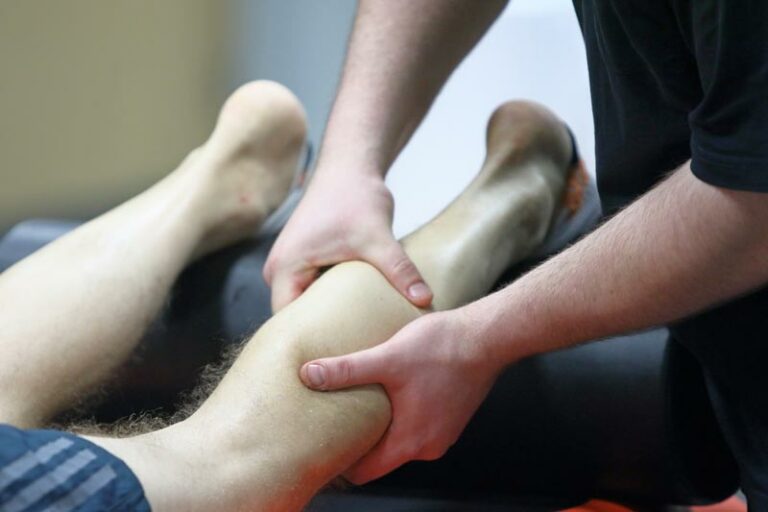A comprehensive guide to pain relief and rehabilitation when addressing Achilles tendinitis.
Does the back of your heel hurt with running? When you jump up for a rebound does your heel cord limit how high you can get? Have you had to decrease the distance of your walk, or stop your daily walk altogether because your Achilles hurts too bad? Any of these situations could be Achilles Tendinitis, a common ailment affecting athletes and active individuals.
In this comprehensive blog, we will explore causes, symptoms, and treatment options for Achilles tendinitis, emphasizing the pivotal role of physical therapy in restoring your strength and allowing you to resume your beloved activities pain-free.
What is Achilles tendinitis?
Achilles Tendinitis is characterized by inflammation of the thick band of tissue connecting to the back of the foot’s bone, known as the Achilles tendon. It often results from sudden increases in activity, improper footwear, or poor biomechanics. Recognizable symptoms include pain and stiffness behind the heel, swelling, and escalating pain with daily activities. If left unaddressed, Achilles tendinitis can become chronic and more challenging to treat.
Physical therapy is a necessary component of the comprehensive treatment plan for Achilles tendinitis. A skilled Physical Therapist can assist in accelerating the healing process, alleviating pain, improving flexibility and strength, and preventing future recurrences.
How can physical therapy help with Achilles tendinitis?
Manual therapy for Achilles tendinitis
Integral to a comprehensive treatment plan, physical therapy offers accelerated healing, pain relief, enhanced flexibility and strength, and preventive strategies for future occurrences.
Skilled physical therapists employ targeted manual therapy techniques such as deep tissue massage and joint mobilizations to reduce muscle tension and improve tissue flexibility.

Tailored exercises for Achilles tendinitis
A customized exercise program is crucial for rehabilitation. Initially, low-impact exercises such as swimming or cycling may be recommended to maintain cardiovascular fitness while minimizing strain on the Achilles tendon. As progress occurs, standing exercises with gradual increases in tension on the Achilles tendon are introduced to safely strengthen the tissue.
Comprehensive exercise plans will incorporate specific exercises for the ankle and foot, as well as the hips and core, areas that can also affect the feet. To ensure a thorough approach to healing, exercises will include both straight knee movements as well as bent knee movements. This often includes squats in various forms, balance training, and coordination drills with a keen focus on the hip and knee on both sides of the body.
Return to sport after Achilles tendinitis
Once pain and inflammation subside, physical therapists work closely with patients to develop a progressive plan to return to regular activities and sports. This includes patient education, in which PTs seek to ensure their patient understands proper dynamic warm-up techniques,the importance of allowing for rest and recovery time following activity and the value of choosing proper footwear.

Top 4 exercises for Achilles tendinitis
HEEL RAISES
This may be counterintuitive to work the same tissue that is irritated, but it is tried and true! In the standing position, raise onto your toes, then control your descent and repeat for 4 sets of 15 repetitions.
SOLEUS RAISES
The soleus muscle is part of the calf and contributes to the Achilles tendon, so it is important to focus on strengthening this area. Stand with bent knees and perform heel raises. You can make this harder by holding dumbbells at your sides or positioned above your shoulders or by elevating the balls of your feet on a book or a folded towel to allow for more range of motion. Perform 3 sets of 10 repetitions.
TIBIALIS ANTERIOR RAISES
Sitting with your legs stretched out before you, place a kettlebell on your foot. While supporting the calf, move the ankle up and down as if to bring the toes toward your nose, then point them away and repeat. This strengthens the front of the legs and is vital for healthy ankles and knees, which support to your Achilles tendon. Perform 3 sets of 10 repetitions.
KETTLEBELL SQUAT/DEADLIFT
Stand with legs hip-width apart and place a kettlebell or other weight between the legs. Lift the weight, performing a deadlift motion. To increase the difficulty, place a resistance band just above the knees, and simultaneously push the knees apart during the deadlift. Perform 3 sets of 10 repetitions.
A holistic approach to healing from Achilles tendinitis
Beyond exercises, physical therapists educate patients on managing Achilles tendonitis independently through stretching routines, proper footwear selection and activity modifications, reducing the risk of future injuries.
Achilles tendinitis need not be a roadblock. Through dedicated physical therapy treatment, individuals can overcome this condition, regain strength and flexibility, and safely return to their cherished activities. The journey to recovery involves pain management, targeted exercises, biomechanics correction, and a gradual return to activities — all guided by a skilled physical therapist. Don’t let Achilles tendinitis hinder your active lifestyle; take the proactive step toward a pain-free future.

Don't let Achilles pain stop you
As physical therapists, we know the importance of movement for overall health and well-being. From injury recovery to achieving optimal performance, our passion is to help every patient reach their goals and live an active, pain-free life.
